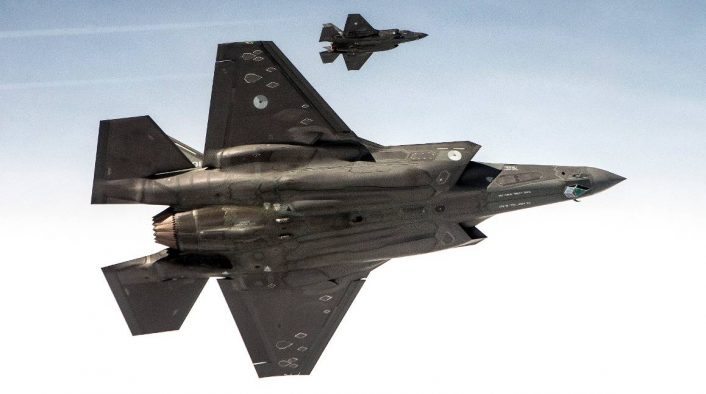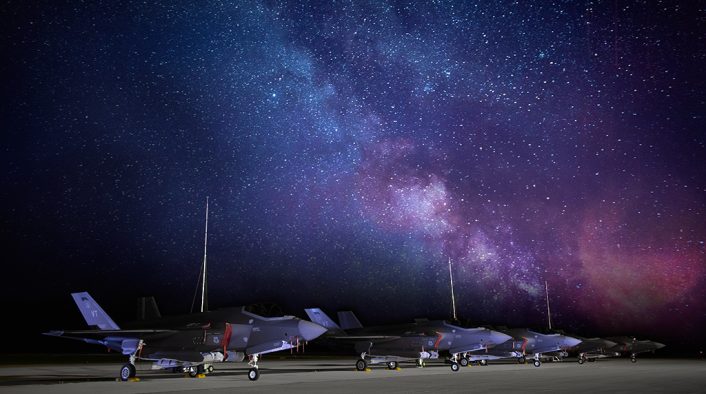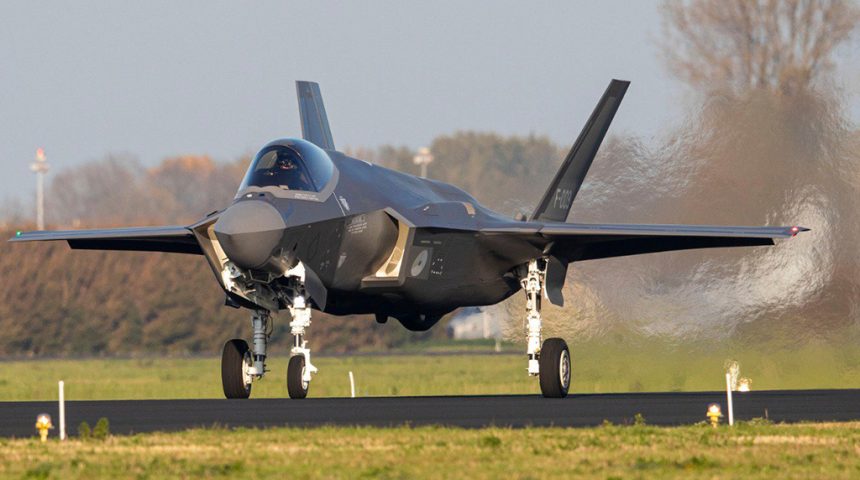The Royal Netherlands Air Force had announced the participation of the F-35s in the one-day exercise. But the risk of thunderstorm forced the Koninklijke Luchtmacht to cancel the participation of its Lightning II jets.
On Aug. 28, 2020, six B-52H Stratofortress bombers took part in Allied Sky, a single-day mission that saw the strategic bombers overfly all 30 NATO nations.
Allied Sky was conducted by two teams: four B-52s with the 5th Bomb Wing, from Minot Air Force Base, North Dakota, deployed to RAF Fairford, UK, were tasked to cover European portion of the mission flying single-ship sorties; two B-52s, also belonging to the 5th Bomb Wing at Minot Air Force Base, flew as a two-ship formation over Canada and the United States.
As reported in detail in this previous article, the one-day mission provided an opportunity for the B-52 to integrate with several NATO nations’ air force fighter aircraft and aerial refueling aircraft: RAF Typhoons and FAF Mirage 2000 over the Baltic off Lithuania; BAF F-16s over Belgium; RDAF F-16s and RNoAF F-35s over Scandinavia; Polish Air Force F-16s and MiG-29s over Poland; Czech Air Force JAS 39 Gripen over Czech Republic; Romanian Air Force F-16s and MiG-21 Lancers over Romania; Bulgarian MiG-29s over Bulgaria; Croatian MiG-21s over Croatia; Hellenic Air Force F-16s over Greece; Italian Air Force Typhoons and F-35s over Italy; Portuguese F-16s over Portugal; Ukrainian Su-27s and MiG-29s over Ukraine.
According to the initial plans, also the F-35A Lightning IIs of the Royal Netherlands Air Force would have had to take part in Allied Sky escorting one of the B-52s. The KLu had announced the participation of the Dutch Lightning II jets on social networks but the mission was cancelled due to bad weather:
In verband met de weersomstandigheden gaat onze deelname aan Operation Allied Sky niet door. https://t.co/P2tiWa2GrU
— Koninklijke Luchtmacht (@Kon_Luchtmacht) August 28, 2020
Indeed, as Sidney Plankman, a Dutch MoD spokesperson confirmed to the Algemeen Dagblad media outlet in an article published on Sept. 19, 2020, the intention was that the brand new F-35s from Leeuwarden Air Base would escort the B-52s. However, “there was a great risk of lightnings that day. Therefore we have decided not to do it.” Noteworthy, most probably due to more clement weather conditions, the Norwegian F-35s were able to escort the B-52 that flew up north to Scandinavia on Aug. 28.
On the day before the Algemeen Dagblad article was published, the Dutch MoD issued a news release to explain that the RNLAF F-35s are temporarily not flying with thunderstorms.
“Damaged pipes have been found on F-35A fighters. These are pipes from the On-Board Inert Gas Generation System (OBIGGS) in a fuel tank. All countries with F-35As were advised to avoid flights near storm cells and to protect the aircraft on the ground by a shelter or lightning rod,” says the Dutch MoD statement. “The OBIGGS ensures that the risk of explosion of fuel vapors in the event of, for example, a lightning strike is reduced to a minimum. The damaged pipes can make the fuel tanks less well protected. After damaged pipes were found on 4 (non-Dutch) aircraft, further inspections followed. More damaged pipes were found, including at Dutch F-35As. The cause of the problem is still under investigation.”
The public release also says that the problem with the OBIGGS and the current investigation will not affect the achievement of the Initial Operational Capability (IOC), that the Dutch fleet should declare by the end of 2021.

A well known issue.
The F-35 has suffered from issues with the OBIGGS for several years. The deficiencies with the system that is supposed to pump nitrogen-enriched air into the fuel tanks to inert them were first discovered during tests in 2009. The testing revealed a design fault that could cause the F-35 to explode if struck by lightning. For this reason, the aircraft was restricted from flying within 25 miles of “known lightning conditions” until the issue with the OBIGGS was fixed. Those restrictions were lifted after the OBIGGS was redesigned in 2014 but new flaws in tubing used to circulate inert gas into fuel tanks to prevent explosions were found again. In June 2020, Bloomberg reported that the deliveries of the new F-35s had been halted because of the issue and then started again with the same 25 miles restriction as a safety precaution.
In August 2020, a picture showing Vermont ANG F-35A jets sitting on the ramp at Volk Field, Wisconsin, on Aug. 11, 2020, protected by mobile lightning rods during Northern Lightning Exercise made the news again.

The lightning rods in the image appear to be versions of LBA Technology, Inc‘s portable PLP-38-MOB model, which the Marine Corps also purchased to shield their F-35Bs from lightning strikes at deployed locations in 2018, wrote The War Zone.
But, while lightning rods can help protecting the F-35 Lightning II (a bit of ironic, isn’t it?) when it is on the ground, it looks like there is no other way to safeguard the precious aircraft than keeping it away from thunderstorms when it is airborne. And this can be a problem, both in planning and executing missions, especially those which need to be flown at all costs and in all-weather conditions (like QRA – Quick Reaction Alert).









